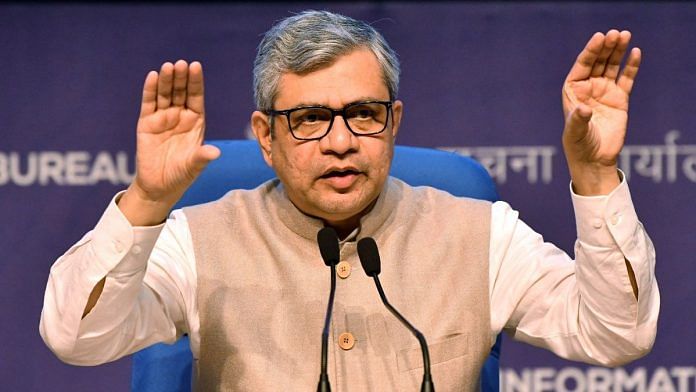New Delhi: The Union Cabinet, chaired by Prime Minister Narendra Modi, approved three semiconductor-related projects worth Rs 1.26 lakh crore Thursday, including the country’s first commercial semiconductor fabrication plant.
Electronics and IT Minister Ashwini Vaishnaw said the construction of all three would begin in the next 100 days and generate 20,000 advanced-technology jobs. Sixty thousand indirect jobs would also open up, he added.
The semiconductor fab – a manufacturing plant that produces semiconductors – will be established by Tata Electronics Private Limited in partnership with Powerchip Semiconductor Manufacturing Corp (PSMC) of Taiwan, at an estimated cost of Rs 91,000 crore in Gujarat’s Dholera. PSMC has 6 semiconductor foundries in Taiwan.
Vaishnaw said this plant was “a big turning point for the nation”, adding semiconductors was a foundational industry and that chips have a lot of downstream-use cases in everything from fans to ACs, fridges, metros, cars, trains and aeroplanes.
The fab will have a capacity of 50,000 wafer starts per month (WSPM). There are roughly 5,000 chips in one wafer.
Vaishnaw told reporters: “Practically, approximately 300 crore chips will be manufactured annually by this plant. These chips will cater to eight sectors – high-powered computing, electric vehicles, defence, telecom, consumer electronics, automobile, power electronics… These chips will be manufactured using advanced technology.”
While the construction of a semiconductor fab typically takes about three to four years, the minister said they would work towards shortening this timeframe.
He also highlighted the country’s first attempt at semiconductor manufacturing was made in 1962, followed by in 1980, 1984, 2005, 2007 and then again in 2011. “…When intentions and policies are clear and precise, then success is achieved. It is under the leadership of Prime Minister Narendra Modi that India’s first commercial semiconductor fab was approved today.”
Also read: ‘Centre gives only Rs 21 per Rs 100’ — Kerala minister questions ‘neglect’ of state in budget speech
Additionally, the Cabinet also approved two assembly, testing, packaging and marking (ATMP) units – one in Gujarat, the other in Assam.
In Assam, Tata Semiconductor Assembly and Test Pvt Ltd (TSAT) will set up the unit in Morigaon with an investment of Rs 27,000 crore. “TSAT semiconductor is developing indigenous advanced semiconductor packaging technologies including flip chip and ISIP (integrated system in package) technologies,” an official release added, stating the capacity of the plant would be 48 million chips per day.
The third plant will be set up by CG Power, in partnership with Renesas Electronics Corporation, Japan and Stars Microelectronics, Thailand in Sanand, Gujarat, with an investment of Rs 7,600 crore.
This plant will manufacture chips for consumer, industrial, automotive and power applications, and will have a capacity of 15 million chips per day.
“In a way, the commitment given by the PM to the nation to build the semiconductor ecosystem is completed today with the approval of these three units,” Vaishnaw said.
Replying to a question, the minister said that of the Rs 76,000 crore outlay announced for the India Semiconductor Mission in December 2021, four projects – three announced on Thursday and the Micron unit announced in June 2023 – would account for about Rs 59,000 crore subsidy outgo.
The minister was also asked why most companies wanted to go to Gujarat. He replied that the ecosystem was complex in the semiconductor industry and that companies chose those states where policies suited them the best.
“If you take the example of Taiwan, there is Hsinchu where industry is concentrated. The reason is that the ecosystem for this is very complex… you need more than 250 chemicals and gases… there are natural agglomeration economies at work. From our side, all states are encouraged to develop the semiconductor ecosystem. All states create their policies. Industries see these policies and decide what suits them,” Vaishnaw said.
(Edited by Tikli Basu)
Also read: Haryana budget walks path of fiscal discipline, while also providing numerous pre-election subsidies



